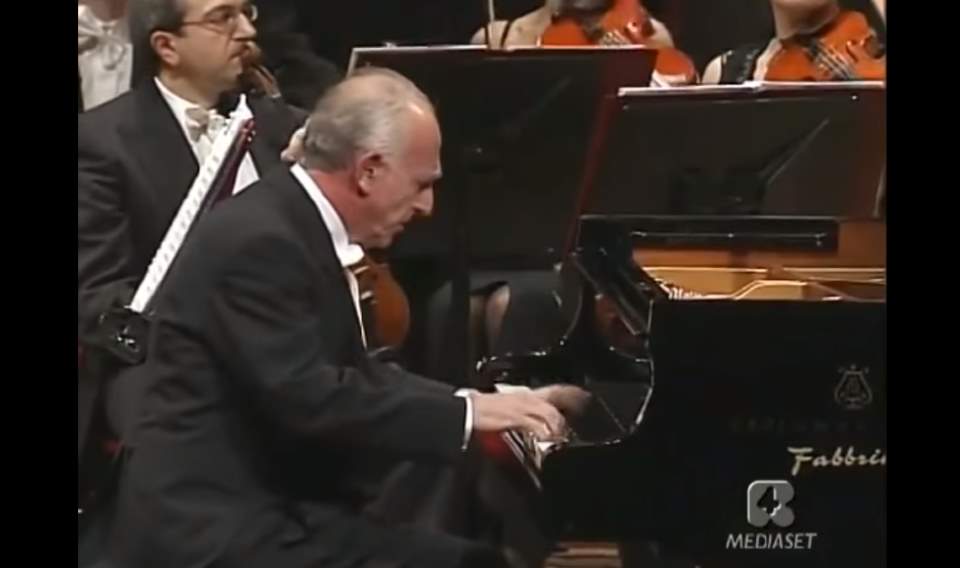Accompanied by the hr-Sinfonieorchester (Frankfurt Radio Symphony Orchestra), the Turkish classical pianist Fazıl Say performs Wolfgang Amadeus Mozart’s Piano Concerto No. 21 in C major, K. 467. Conductor: Peter Oundjian. Recorded on April 28, 2017, at Alte Oper Frankfurt.
Wolfgang Amadeus Mozart’s Piano Concerto No. 21
Mozart’s Piano Concerto No. 21 in C major, K. 467, is one of his most famous and beloved compositions for piano and orchestra. It was composed in Vienna in 1785 when Mozart was 29 years old (completed on March 9, 1785, four weeks after the completion of the previous Piano Concerto No. 20 in D minor, K. 466).
The concerto is characterized by its memorable and melodic themes. Mozart’s gift for crafting captivating melodies is evident throughout the work, particularly in the second movement, which is considered one of his most sublime and poignant creations.
Movements
With start times in the video:
- Allegro maestoso [00:29]
- Andante [14:57]
- Allegro vivace assai [22:52]
1. Allegro maestoso
Mozart’s Piano Concerto No. 21 in C major, K. 467, features a magnificent first movement marked “Allegro maestoso” (fast and majestic). The movement follows the structure of a typical sonata form, with an exposition, development, and recapitulation.
The movement begins with a grand orchestral introduction, presenting a regal theme in C major. The piano enters with its own virtuosic and brilliant theme, engaging in a dialogue with the orchestra. This exposition section develops and presents the main musical ideas.
The development section takes the established themes and subjects them to transformations. Mozart explores different keys, textures, and harmonies, creating tension and musical exploration. The piano often showcases improvisatory skills within the framework of written music.
The recapitulation brings back the themes from the exposition, reintroducing them in a more unified manner. It reaffirms the key of C major and provides a sense of resolution. Mozart often varies or embellishes the themes in this section.
The orchestration throughout the movement is rich and vibrant, with the full orchestra contributing to the grandeur of the sound. Mozart skillfully balances the interplay between the solo piano and the various sections of the orchestra, creating a harmonious dialogue.
2. Andante
The second movement of the concerto is a lyrical and introspective piece that contrasts with the lively and energetic first movement. It is written in the key of F major, providing a change in mood and tonality.
The movement opens with a delicate and tender melody introduced by the piano. This melody is then developed and expanded upon by both the piano and the orchestra, creating a sense of dialogue and interaction between the soloist and the ensemble.
Mozart’s gift for crafting captivating and expressive melodies is particularly evident in this movement. The melody is characterized by its flowing and singing quality, evoking a sense of grace and tranquility.
Throughout the movement, Mozart employs various expressive techniques, such as ornamentation, subtle dynamic changes, and expressive phrasing, to enhance the emotional depth and beauty of the music.
The orchestration in the second movement provides a gentle and supportive accompaniment to the piano’s melodic lines. The strings, woodwinds, and occasionally the horns contribute to the overall serene and delicate atmosphere.
The overall character of the second movement is one of introspection and tenderness. It carries a sense of emotional depth and introspective contemplation, inviting listeners to immerse themselves in its serene and poetic qualities.
The second movement of Mozart’s Piano Concerto No. 21 stands out as a poignant and intimate musical expression within the larger work. Its melodic beauty, delicate orchestration, and emotive character make it a cherished part of the concerto and a standout moment in Mozart’s piano repertoire.
This movement is famous in its own right and has been frequently performed and recorded as an independent piece. Its timeless appeal continues to captivate audiences with its profound expressiveness and inherent beauty.
3. Allegro vivace assai
The finale of Mozart’s Piano Concerto No. 21 marked “Allegro vivace assai”, which means “very fast and lively”. It is a rondo, a musical form characterized by the recurrence of a main theme interspersed with contrasting sections. It is written in the key of C major, providing a sense of brightness and energy.
The movement opens with a spirited and joyful cadenza. Then, the piano joins in with a theme reminiscent of the finale of Michael Haydn’s Symphony No.18 in C major and further elaborates.
Throughout the movement, Mozart showcases his virtuosic writing for the piano. The soloist performs rapid scales, arpeggios, and intricate passages, displaying technical brilliance and dexterity.
The main theme is interspersed with contrasting episodes, each with its own distinct character and melodic material. These episodes provide moments of contrast and variety, showcasing different moods and musical ideas.
The orchestration in the third movement is lively and vibrant, with the orchestra engaging in playful exchanges with the piano. There are frequent interplay and dialogue between the soloist and the various sections of the orchestra.
The overall character of the third movement is one of high energy, excitement, and joy. The lively tempo, virtuosic piano passages, and spirited themes create a sense of exhilaration and celebration.
The movement culminates in a brilliant and triumphant finale, with the piano and orchestra joining forces in a thrilling conclusion.
Sources
- Mozart’s Piano Concerto No. 21 on Wikipedia
- Chopin: Scherzo No. 3 [İlyun Bürkev] - September 14, 2024
- César Franck: Violin Sonata [Argerich, Capuçon] - September 8, 2024
- Beethoven: Piano Sonata No. 23 “Appassionata” [Anna Fedorova] - September 7, 2024
